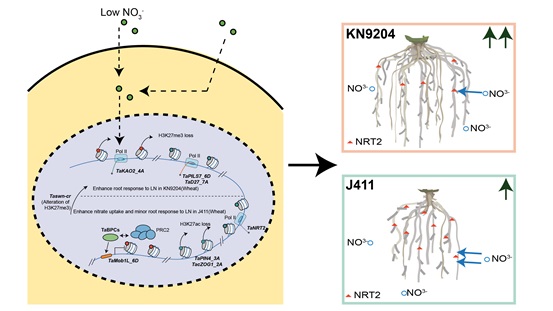Wheat (Triticum aestivum) stands as a critical global food crop, with its productivity heavily dependent on nitrogen fertilizer use. The imperative to enhance nitrogen use efficiency (NUE) in wheat becomes apparent as a countermeasure to the adverse impacts of excessive nitrogen application. Effective nitrate absorption, a key factor in NUE, is intricately linked to the architecture of the root system. However, there remains a notable research gap concerning the establishment of wheat root morphology under varied nitrogen conditions, particularly within the realms of epigenomics and transcriptional regulation.
Led by Prof. XIAO Jun at the Institute of Genetics and Developmental Biology (IGDB), Chinese Academy of Sciences, this study delves into the epigenomic landscape of two representative wheat cultivars—Kenong 9204 (KN9204) and Jing 411 (J411)—known for their divergent responses to low nitrogen (LN) conditions, indicative of varied NUE.
The research unveils the cultivar specificity of distal H3K27ac regulatory regions, shedding light on their pivotal role in shaping distinct agronomic traits, such as root morphology. Notably, the study underscores that differences in histone modifications, rather than variations in DNA sequences, significantly influence the disparate expression patterns of genes related to nitrogen metabolism in these cultivars.
The dynamic alterations in histone modifications (H3K27ac and H3K27me3) emerge as key drivers of distinct adaptation strategies in KN9204 and J411 under low-nitrogen conditions, impacting both root development and the induction of high-affinity nitrate transporters, specifically Nitrate Transporter 2 (NRT2).
Importantly, evidence from histone deacetylase inhibitor treatment and transgenic plants with impaired H3K27me3 methyltransferase function illustrates how modifications in histone profiles can fundamentally influence the preferred adaptation strategies in wheat.
Epigenetic regulation determination of low-ni trogen adaptation strategy in wheat cultivars
Contact:
Prof. XIAO Jun
Institute of Genetics and Developmental Biology, Chinese Academy of Sciences
 Epigenetic regulation determination of low-ni trogen adaptation strategy in wheat cultivarsContact:Prof. XIAO JunInstitute of Genetics and Developmental Biology, Chinese Academy of SciencesEmail: jxiao@genetics.ac.cn
Epigenetic regulation determination of low-ni trogen adaptation strategy in wheat cultivarsContact:Prof. XIAO JunInstitute of Genetics and Developmental Biology, Chinese Academy of SciencesEmail: jxiao@genetics.ac.cn CAS
CAS
 中文
中文




.png)
